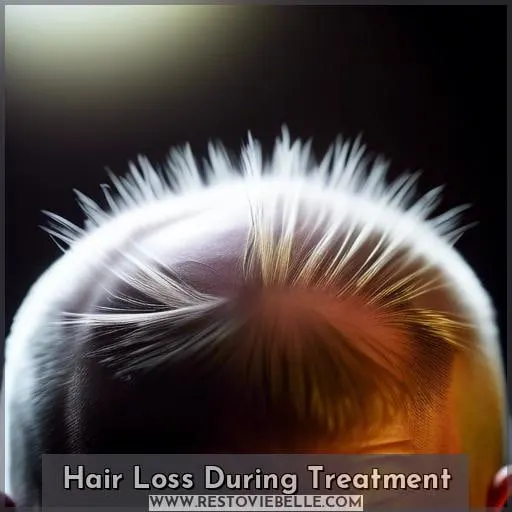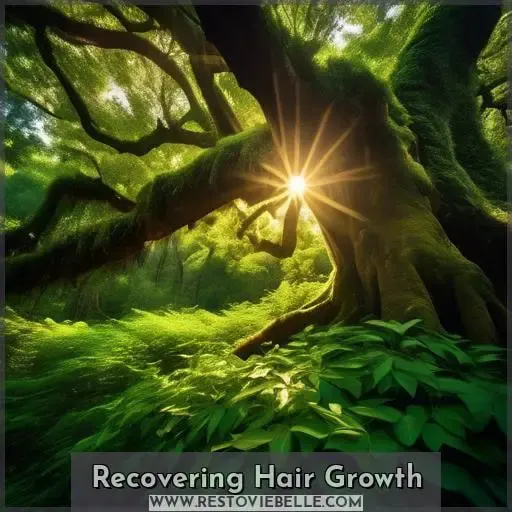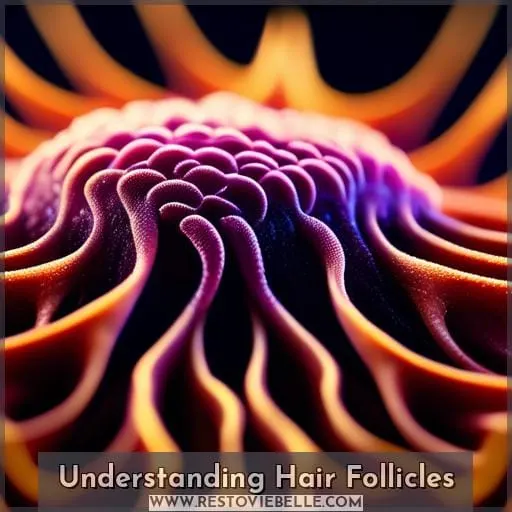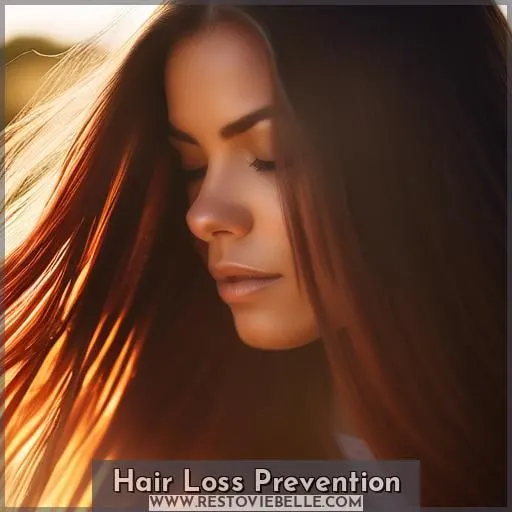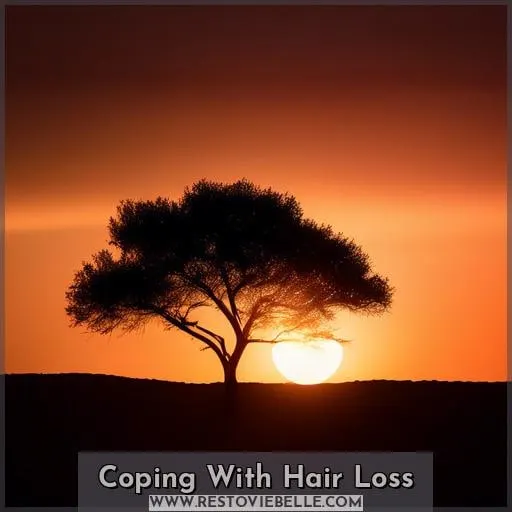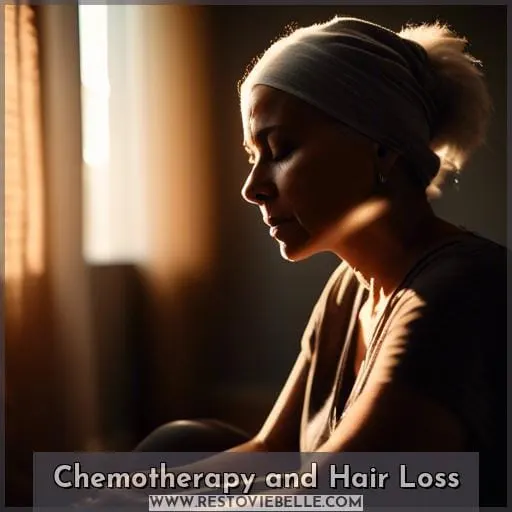This site is supported by our readers. We may earn a commission, at no cost to you, if you purchase through links.
 While you might not feel your hair growing, understanding the science behind hair follicles can empower you to navigate hair loss and regrowth effectively.
While you might not feel your hair growing, understanding the science behind hair follicles can empower you to navigate hair loss and regrowth effectively.
Hair grows in a cyclical pattern, with active growth phases followed by rest periods.
Various factors like chemotherapy can disrupt this cycle.
By delving into the physiology of hair and strategies to foster regrowth, you can regain a sense of control and mastery over this natural process.
Table Of Contents
- Key Takeaways
- Hair Loss During Treatment
- Recovering Hair Growth
- Understanding Hair Follicles
- Hair Loss Prevention
- Coping With Hair Loss
- Covering Your Head
- Chemotherapy and Hair Loss
- Frequently Asked Questions (FAQs)
- Can diet or specific nutrients influence the rate at which hair grows?
- Are there any genetic factors that determine hair texture or growth speed?
- How does the change of seasons affect hair growth and shedding patterns?
- Can psychological factors such as stress or anxiety have a long-term impact on hair growth?
- Is it possible to stimulate dormant hair follicles to increase hair density?
- Conclusion
Key Takeaways
- Chemotherapy targets rapidly dividing cells, which includes hair follicles, leading to hair loss on the scalp and body as a common side effect. The extent of hair loss varies based on the type of chemotherapy, dosage, and individual sensitivity.
- Scalp cooling caps and Minoxidil are methods that may reduce the severity of hair loss during chemotherapy and potentially hasten the regrowth process, although no methods can guarantee the prevention of hair loss.
- Hair follicles, responsible for hair production, go through growth phases (anagen, catagen, telogen) that regulate the hair life cycle. Stem cells and melanin production within these follicles play crucial roles in hair health and regrowth.
- Coping with hair loss involves acceptance, seeking support from groups, friends, and family, and using wigs, scarves, or hats to cover up during the regrowth process. It’s important to avoid products claiming to be miracle cures and to have patience with the regrowth process.
Hair Loss During Treatment
During chemotherapy, you’ll likely start to experience hair loss about 2 to 4 weeks after your first treatment session. This process, while distressing, is a common side effect due to the nature of chemotherapy drugs targeting rapidly dividing cells, including those in your hair follicles.
The timeline for hair loss can vary, with some individuals noticing hair thinning or loss within the initial weeks of treatment. The extent of hair loss can range from slight thinning to complete baldness, depending on the type of chemotherapy, dosage, and your individual sensitivity.
As you navigate this challenging period, understanding the structure and function of hair follicles can offer insights into why hair loss occurs and what to expect regarding regrowth. Hair follicles, embedded in the skin’s layers, are responsible for hair production.
Damage to these follicles by chemotherapy can lead to hair loss not only on the scalp but also across the body, including eyelashes, eyebrows, and pubic areas.
In terms of hair regrowth, it’s encouraging to know that hair usually begins to grow back within a few weeks to months after completing chemotherapy, although the new hair may initially have a different texture or color.
This change is often temporary, with many people seeing their hair return to its pre-treatment state within 3 to 6 months.
Preventing hair loss during chemotherapy is challenging, with no guaranteed methods to avoid it. However, strategies like scalp cooling caps and the use of minoxidil have been explored for their potential to reduce hair loss severity or speed up regrowth.
Scalp cooling caps work by reducing the blood flow to the scalp, thereby limiting the amount of chemotherapy drug reaching the hair follicles. Minoxidil, on the other hand, may help in hastening the regrowth process, although it’s not proven to prevent hair loss.
Coping with the emotional impact of hair loss involves a range of strategies, from practical steps like cutting hair short before treatment to psychological support through talking about your feelings and connecting with others experiencing similar challenges.
Covering your head with wigs, hats, or scarves can also provide comfort and help manage the visible effects of hair loss.
In summary, while chemotherapy-induced hair loss is a common and often distressing side effect, understanding the process and knowing what to expect can empower you to navigate this challenge more effectively.
With time, patience, and care, hair regrowth is a hopeful outcome for many undergoing treatment.
Recovering Hair Growth
After enduring the challenges of cancer treatment, you’ll find that within the sanctuary of recovery, your hair begins its journey back to regrowth, often emerging with a new texture or hue that marks a fresh start.
The recovery of hair growth is a multifaceted process influenced by various factors.
Dietary supplements, essential oils, and scalp massage are potential interventions that may support hair regrowth.
Understanding the function of hair follicles is crucial for comprehending how hair grows back after treatment-related loss.
Radiation therapy and the use of scalp cooling caps are significant considerations in the context of recovering hair growth post-treatment.
Emotional support also plays a vital role in the recovery process, impacting overall well-being and potentially influencing hair regrowth.
Embracing the biological basis of hair growth and exploring methods to mitigate or reverse hair loss can empower you on your journey to recovering hair growth.
Understanding Hair Follicles
As you’re waiting for your hair to recover post-chemotherapy, it’s helpful to understand that each hair follicle, a complex structure beneath your skin, is responsible for the growth of new hair. Delving into the hair follicle structure reveals a world where stem cells and melanin production play crucial roles, not just in hair color but in its very creation. The growth phases—anagen, catagen, and telogen—underscore the dynamic nature of hair growth, influenced by the follicle’s anatomy and size.
| Aspect | Detail | Importance |
|---|---|---|
| Follicle Anatomy | Layers, hair bulb | Basis for hair production |
| Growth Phases | Anagen, Catagen, Telogen | Regulates hair life cycle |
| Stem Cells | Regeneration | Key to new hair growth |
| Melanin Production | Determines hair color | Adds to hair’s uniqueness |
Understanding these elements empowers you with knowledge about the regrowth process, highlighting the sebaceous glands‘ role in maintaining hair health.
Hair Loss Prevention
How can you transition from understanding the structure and function of hair follicles to exploring methods to prevent hair loss during cancer treatment? While no method can fully guarantee the preservation of your hair during chemotherapy, there are strategies and treatments that may help reduce the extent of hair loss.
- Scalp cooling caps: These may decrease the amount of chemotherapy reaching hair follicles, potentially lessening hair loss.
- Dietary supplements: Certain vitamins and minerals support overall hair health, possibly aiding in hair retention.
- Essential oils: Some find that oils like peppermint and rosemary support scalp health and hair strength.
- Stress reduction: Techniques such as meditation and yoga could minimize hair loss by reducing stress-related damage to hair follicles.
- Natural remedies: While evidence is limited, some advocate for gentle, natural hair care products to maintain follicle integrity during treatment.
Coping With Hair Loss
Coping with hair loss can be challenging, especially when it’s gradual or complete.
- Acceptance: Recognize that hair loss is a common side effect of certain treatments or conditions, and it’s not your fault.
- Support: Join a support group or talk to friends and family about your feelings.
- Covering up: Choose a wig, scarf, or hat that suits your style and preferences.
- Patience: Regrowth may take time, and new hair can be different in texture or color.
- Avoid miracle cures: Focus on proven treatments and healthy habits, not unproven products.
Complete Hair Loss
Where can you find support and strategies to manage the emotional and practical challenges of complete hair loss during cancer treatment? Understanding the underlying causes, such as genetic predisposition or hormonal changes, is crucial. Here’s a concise guide:
| Factor | Role in Hair Loss |
|---|---|
| Genetic Predisposition | Influences susceptibility |
| Hormonal Changes | Can trigger hair thinning |
| Nutritional Factors | Essential for follicle health |
| Autoimmune Response | May lead to hair removal |
Gradual Hair Loss
You’ll likely notice your hair thinning gradually, which can be a less shocking experience than complete hair loss. However, it still requires a strategy to manage both the physical and emotional effects.
Stress impact and hormonal influence can exacerbate thinning. Seek emotional support, consider nutritional factors for follicle health, and explore cold caps to mitigate loss.
Genetic predisposition may affect regrowth, altering hair color and follicle size.
Covering Your Head
When considering options for covering your head during hair loss, wigs, hats, scarves, and turbans are effective and comfortable choices. These alternatives not only serve practical purposes like protection and warmth for the scalp but also allow for personal expression.
The diversity in style and design caters to individual preferences, ensuring solutions that reflect personality and respect cultural significance. Seasonal variations are also important to consider for year-round comfort. Embracing these options can empower individuals, offering a sense of control over appearance during recovery.
Wigs provide a versatile solution, offering the appearance of natural hair and can be selected based on color, texture, and style to match personal preferences or to experiment with new looks. They can be particularly beneficial for extensive hair loss, providing confidence and a significant self-esteem boost.
Hats are a fashion-forward option that can range from casual baseball caps to designer pieces. They are excellent for hiding hair loss and protecting the head from the elements. When selecting a hat, comfort is key, and a soft, flexible hat may feel better on the scalp than a rigid one.
Scarves offer a creative way to cover hair loss, with an almost infinite number of designs available. They can be styled in various ways to cover the head, providing flexibility and a means to express one’s style.
Turbans are popular for their blend of durability and softness, making them a comfortable choice for protecting the head from the sun or covering hair loss during activities like swimming. They come in a variety of designs suitable for both daytime and dressier occasions.
When choosing headwear, the fabric is an important consideration. Cotton is soft and comfortable, ideal for complete hair loss, and offers sun protection. Silk scarves are perfect for warmer months, providing elegance and comfort. Bamboo is soft, breathable, and hypoallergenic, making it an excellent choice for sensitive skin.
For those experiencing hair loss due to medical treatments like chemotherapy, headwear can be a helpful tool during the transition period and beyond. It’s important to choose headwear that is soft, breathable, and comfortable to avoid overheating or irritation.
In summary, wigs, hats, scarves, and turbans offer a range of options for covering the head during hair loss. These choices not only provide practical benefits but also enable personal expression and comfort, helping individuals navigate this challenging period with confidence and style.
Chemotherapy and Hair Loss
While exploring options to cover your head, it’s crucial to understand the underlying cause of hair loss during chemotherapy. These treatments target rapidly dividing cells, which unfortunately includes the cells in your hair follicles.
This can lead to hair loss not only on your scalp but also on other parts of your body.
Scalp cooling caps have emerged as a method to potentially reduce this effect, though they carry their own risks. Minoxidil, often surrounded by myths, may hasten hair regrowth but doesn’t prevent loss.
When choosing a wig, consider how it will look and feel, aiming for comfort and a style that empowers you. Remember, protecting your scalp from the sun is vital during this sensitive period.
The emotional impact of hair loss is significant, and it’s important to acknowledge and address these feelings as you navigate through your treatment journey.
Frequently Asked Questions (FAQs)
Can diet or specific nutrients influence the rate at which hair grows?
Adequate intake of specific nutrients like proteins, vitamins, and minerals can indeed promote healthier hair growth and potentially influence its rate.
Micronutrients such as vitamins and minerals play an important, but not entirely clear role in normal hair follicle development and immune cell function. Deficiency of such micronutrients may represent a modifiable risk factor associated with the development, prevention, and treatment of alopecia.
The role of nutrition and diet in treating hair loss represents a dynamic and growing area of inquiry. In this review, we summarize the role of vitamins and minerals, such as vitamin A, vitamin B, vitamin C, vitamin D, vitamin E, iron, selenium, and zinc, in non-scarring alopecia.
Plain Language Summary: Hair loss is a common problem that may be improved with vitamin and mineral supplementation. While supplementation is relatively affordable and easily accessible, it is important to know which vitamins and minerals are helpful in treating hair loss.
Are there any genetic factors that determine hair texture or growth speed?
Like a tree rooted in your DNA, your genes largely dictate your hair’s texture and growth speed.
Genetic factors influence hair density, length, color, and texture.
How does the change of seasons affect hair growth and shedding patterns?
Seasonal changes can influence hair growth and shedding. Peak shedding often occurs in summer, with a secondary peak in spring, while growth rates are lowest in winter.
Can psychological factors such as stress or anxiety have a long-term impact on hair growth?
Chronic stress or anxiety can indeed impact hair growth long-term.
Stress hormones impair stem cells necessary for hair regeneration.
This can lead to extended resting phases for hair follicles, hindering regrowth.
Is it possible to stimulate dormant hair follicles to increase hair density?
Yes, it’s possible to stimulate dormant hair follicles to increase hair density. Research shows that peppermint oil (PEO) significantly promotes hair growth. It does this by increasing dermal thickness, follicle number, and depth. It also enhances alkaline phosphatase activity and IGF-1 expression, which are key for hair growth.
Additionally, medications like finasteride and minoxidil have been proven effective in reactivating hair follicles and promoting regrowth.
Natural methods, including scalp massages and using essential oils like rosemary and peppermint, can also support hair follicle stimulation.
Conclusion
Just as a seed silently sprouts beneath the earth, you won’t feel your hair grow, but understanding its journey can illuminate the path to overcoming hair loss.
By exploring the science of hair follicles and embracing strategies for regrowth, you’re equipped to navigate the challenges posed by treatments like chemotherapy.
Embrace the cycle of loss and renewal, and you’ll find strength in the regrowth that follows.

